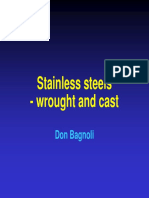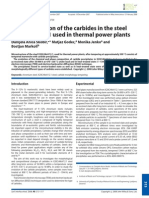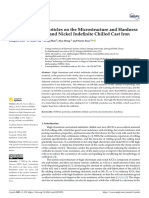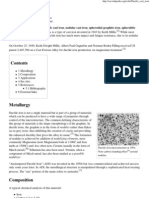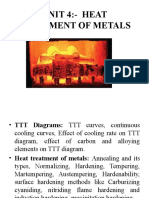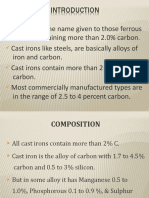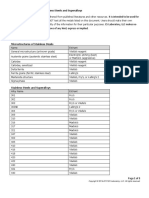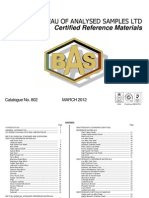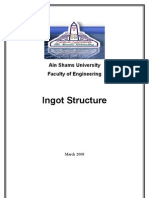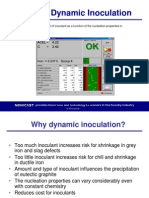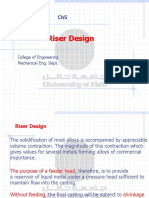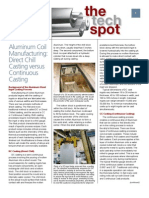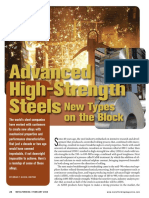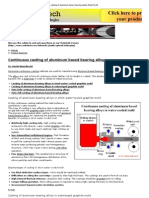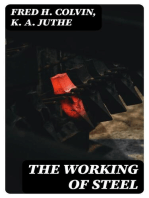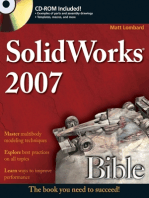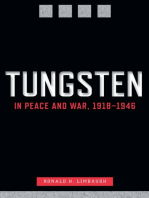Professional Documents
Culture Documents
Duplex Centifugally Cast
Duplex Centifugally Cast
Uploaded by
joseritoOriginal Description:
Copyright
Available Formats
Share this document
Did you find this document useful?
Is this content inappropriate?
Report this DocumentCopyright:
Available Formats
Duplex Centifugally Cast
Duplex Centifugally Cast
Uploaded by
joseritoCopyright:
Available Formats
Duplex
DUPLEX
Centrifugally cast duplex stainless steel
Discussion of benefits
Shawn Martin, Greg Mooren, Alan Holtz, Spuncast, Inc, USA
Introduction
Benefits
Principles of centrifugal castings
Process Control
When it comes to metal forming,
casting metal can be one of the simplest, most cost-effective routes to a
near net shape manufactured good.
Centrifugal casting in particular has
the capability of utilizing these desirable benefits during the production of cylindrical stainless steel
products.
Significant cost savings can be a result of process control.
At Spuncast raw materials purchased
are received and the chemistry evaluated. The chemistries are acquired
through one of three methods: auditing pieces from various locations
in that lot on the spectrometer, the
purchased scrap comes with a certified chemistry, or a 100lb sample of
material is melted down and a
chemistry slug evaluated. This
known/averaged chemistry creates
the necessary control needed when
working with low carbon alloys
(such as Duplex). Charge sequence
and temperature control also play a
Centrifugal casting is a process
where molten metal is funneled
into a rotating mold (commonly
700 to 1300 rpm). The rotation of
the die creates centrifugal force
which thrusts the metal towards the
mold wall.
Figure 1: Cross-Section of a Horizontal Die with a Line Designating its Axis of Rotation.
Centrifugal casting can be performed
horizontally or vertically. The aspect
ratio of the part to be cast is what determines which of these two techniques are used. When the diameter
of the desired part is large in comparison to the overall-length (ring
shaped), vertical casting is most
commonly used. Likewise, when the
length is larger compared to the diameter (tube shaped), horizontal
casting setups are used.
www.stainless-steel-world.net
large role in controlling process
variables. Charge sequence can control the amount of elemental recovery, as well as the cycle time of each
melt. Temperature control allows
the melter opportunity to avoid superheating the melt, ultimately affecting the chemistry, and tap the
furnace with the exact amount of
temperative increase needed to pour
the casting above but close to its
liquidus temperature. Another way
S T A I N L E S S
S T E E L
temperature control plays a key role
is during the casting solidification
process. Centrifugal casting promotes directional grain growth during solidification, as shown in the
pictures below.
Figure 2: Casting cross-section macro-etched with Hydrogen
Peroxide and Muriatic Acid, displaying direction solidification
and grain growth from the outer diameter to the inner
diameter.
Secondary Refining
The centrifugal forces promote metal cleanliness by forcing the nonmetallics (less dense) to the inner
diameter of the casting. As solidification takes place, the inner surface
acts as a riser feeding the outer diameter with the metal it needs to
produce a solid, dense casting. The
less dense materials (the dirt, dross,
or slag) that were forced to the bore
of the casting can now be subsequently machined off. Since the use
of gating and risers are eliminated,
the productions of these castings
have an extremely high casting
yield.
Shapes and Sizes
Centrifugal casting is most appropriate when producing relatively simple cylindrical shaped parts. The list
that follows shows the size ranges
and limitations for the production
of parts using this unique casting
process.
W O R L D
D E C E M B E R
2 0 0 7
69
Size Limits: [1]
Diameter: Up to 3 m (10 feet)
Length: 15 m (50 feet)
Wall Thickness: 2.5 mm to 125 mm (0.1 - 5.0 in)
OD Tolerance: as fine as 2.5 mm (0.1 in)
ID Tolerance: can be 3.8 mm (0.15 in)
Spuncast Avg.
Wrought Spec.
(S32205)
Advantage and Limitation
Centrifugal castings can be more
cost effective than forgings and
have properties that surpass those of
most other casting processes. This
centrifugally cast dense structure
creates castings with a longer life.
These parts also can withstand
greater loads and impacts without
fracturing.
Forged Roll
(Billet)
Wrought Material Properties
Double Energy Costs
Significant amount of Machining.
Low Tooling Costs
Sand
Casting
Centrifugal
Casting
High material cost
Low Manufacturing Costs
Improved Proprieties
Secondary Refining (denser)
Directional Solidification
Strength Limitations
Micro-porosity
Inherent Inclusions
Duplex Stainless Steel
Property Comparison
Mechanical Property Comparison:
Wrought vs. Centrifugally Cast
The primary U.S specification for
cast duplex stainless steels is ASTM
A890. There are eight grades within
this specification. To date there is
no accepted specification for a cast
lean duplex. The following data is a
comparison of achievable cast properties to wrought specifications for
duplex grades 4A and 1B. These
two were selected because they both
have an abundance of history and
data available. There are other duplex grade properties available, but
the information is fairly limited.
Grade 4A
Yield
(MPa)
Yield
(ksi)
Elongation
(%)
802.5
116.4
557.1
80.8
32.7
760
110
550
80
15
2205 - J92205
Grade 1B
2550 - J92205
Two samples of centrifugally cast Duplex Stainless Steel parts:
UTS
UTS
(MPa)
(ksi)
Yield
(MPa)
Yield
(ksi)
Elongation
(%)
731
106
534
77.4
28.4
621
90
450
65.3
25.0
Spuncast Avg.
Wrought Spec.
(S32550)
Table 3: Mechanical property summary for 16 cast and
heat treated Tensile bars (1120C Water Quench)
Several wrought material grades
have recently been introduced that
accomplish cost saving by lowering
the amount of Ni, but none of these
were designed for castability (specifically centrifugal casting).
SCLean
SCLean - Spuncasts Cast Grade of
Lean Duplex
Table 4: SCLean - Nominal Chemistry
y
C
0.025
Mn
4.2
Si
0.68
P
0.02
S
0.005
Cr
22.25
Ni
1.5
W
0.013
Cu
1
Nb
0.06
V
0.05
Al
0.005
Zr
0.007
N
0.19
Test Sample
Shape and Size
Table 1: Above is a list of advantages and limitations to acknowledge when selecting a form of product manufacturing.
UTS
(ksi)
Table 2: Mechanical property summary for 70 cast and
heat treated tensile bars (1120C Water Quench)
Figure 3: Size Limitations for Centrifugal Casting
Utilizing a vertical casting orientation, more complex shapes are quite
possible by the use of either chemically bonded sand inserts or investment (lost-wax) shell inserts.
UTS
(MPa)
1 - 7489
2 - 7490
3 - 7496
4 - 7497
Average
UTS
(MPa)
639
632
628
623
630
UTS
(ksi)
92.71
91.71
91.12
90.35
91
Yield
(MPa)
483
476
470
486
479
Yield
(ksi)
70.01
69.06
68.17
70.45
69
Mo
0.49
Elongatio
n (%)
32.31
39.20
Furnace /
HT
1120oC WQ
1120oC WQ
34.56
32.13
34.6
1120oC WQ
1120oC WQ
Table 5: Mechanical property breakdown for tensile
bars cut from the heat treated castings (1120F Water
Quench)
Stress-Stain Diagram
Decanter Centrifuges
Duplex
Stainless
Steel
Duplex
Stainless
Steel
Solids Discharge
Main Effluent
Figure 4: Decanter Centrifuges - Separating solids from liquids plays a key role in countless industrial, food and waste treatment processes.
On-ship Hydraulic Accumulators
Figure 6: Stress-Strain curve recorded from one of the
SCLean tensile bars pulled (Sample 1-7497).
Figure 5: On-Ship Hydraulic Accumulators - Energy storage basin in which hydraulic fluids are held
under pressure by a peripheral source.
70
S T A I N L E S S
S T E E L
W O R L D
D E C E M B E R
2 0 0 7
As stated earlier, maximizing mechanical properties while minimizing the use of expensive raw materials was the primary objective. One
without the other (mechanical
properties / lower cost per kg) is of
no use.
www.stainless-steel-world.net
Duplex
The previously shown mechanical
properties were made at the following price:
SCLean = $1.67 / Kg (based on
$44.31/Kg Ni - LME)
For reference: That same week had
the following prices:
CD4MCuN = $ 3.88 / Kg
Duplex4A = $ 4.54 / Kg
Conclusion
Centrifugal castings use directional
solidification and pressure from the
centrifugal force to create castings
with a denser more sound structure
exhibiting superior physical properties to that of statically poured castings.
It has been made clear that centrifugal casting is a versatile process with
benefits in the areas of mechanical
properties and overall process costeffectiveness. The utilization of
this process can be beneficial when
producing a variety of products.
One particular example shown was
the specific development of SCLean
as a castable lean duplex.
www.stainless-steel-world.net
Reference(s)
Centrifugal Casting. (2007) In efunda, engineering fundamentals.
Retrieved 13:08, July 2nd. 2007, from http://www.efunda.com/processes/metal_processing/centri_casting.efm
About the authors
Shawn Martin
Academic Education & Degrees:
Bachelors of Science - Material Science & Engineering,
Michigan Technological University
Current Position:
Metallurgist,
Spuncast, Inc, Watertown, WI USA
Greg Mooren
Academic Education & Degrees:
Bachelors of Science - Material Science & Engineering,
Michigan Technological University
Current Position:
Metallurgist, Spuncast, Inc, Watertown, WI USA
Alan Holtz
Academic Education & Degrees:
Bachelor of Arts - History,
University of Pennsylvania
Bachelor of Science - Metallurgical Engineering,
University of Missouri - Rolla
Current Position: Vice President - Sales & Engineering,
Spuncast, Inc, Watertown, WI USA
S T A I N L E S S
S T E E L
W O R L D
D E C E M B E R
2 0 0 7
71
You might also like
- SDSS For ValvesDocument4 pagesSDSS For ValvesAhmed Ibrahim Ahmed EissaNo ratings yet
- Seminar Special CastingDocument16 pagesSeminar Special CastingAjith SreenathNo ratings yet
- Saline WaterDocument20 pagesSaline WaterAdroNo ratings yet
- UMCo 50Document3 pagesUMCo 50San ReyNo ratings yet
- Duplex Stainless Steel 329 or 1.4460 PDFDocument2 pagesDuplex Stainless Steel 329 or 1.4460 PDFtien100% (1)
- Outokumpu Supra Range DatasheetDocument12 pagesOutokumpu Supra Range DatasheetMichelNo ratings yet
- Shaw ProcessDocument2 pagesShaw ProcessSuresh KumarNo ratings yet
- An Introduction To Shaw Process by MustaDocument14 pagesAn Introduction To Shaw Process by MustaMarthinNo ratings yet
- 4 - Stainless Steels - Wrought and CastDocument24 pages4 - Stainless Steels - Wrought and Castdennykvg100% (1)
- Foundry of Non-Ferrous Metal AlloysDocument59 pagesFoundry of Non-Ferrous Metal AlloysNarender KumarNo ratings yet
- Characterization of The Carbides in The Steel X20CrMoV12.1 Used in Thermal Power PlantsDocument5 pagesCharacterization of The Carbides in The Steel X20CrMoV12.1 Used in Thermal Power PlantsHilarioPerezNo ratings yet
- Crystals 12 00978Document9 pagesCrystals 12 00978irmaNo ratings yet
- Application Manual Chapter 6 - Feeding & GatingDocument148 pagesApplication Manual Chapter 6 - Feeding & GatingVishal MaliNo ratings yet
- The Current State of Worldwide Standards of Ductile IronDocument8 pagesThe Current State of Worldwide Standards of Ductile IronN.PalaniappanNo ratings yet
- Core Sand MaterialDocument20 pagesCore Sand MaterialsudhirNo ratings yet
- 4 Draft or Taper AllowanceDocument5 pages4 Draft or Taper AllowanceAde PuspitaNo ratings yet
- Cores and CoremakingDocument12 pagesCores and CoremakingupenderNo ratings yet
- Effect of Boron in D.I.Document2 pagesEffect of Boron in D.I.Sachin KumbharNo ratings yet
- Ductile Iron, Also Known As Ductile Cast Iron, Nodular Cast Iron, Spheroidal Graphite Iron, Spherulitic Graphite Cast IronDocument3 pagesDuctile Iron, Also Known As Ductile Cast Iron, Nodular Cast Iron, Spheroidal Graphite Iron, Spherulitic Graphite Cast IronRajesh N Priya GopinathanNo ratings yet
- Unit 4:-Heat Treatment of MetalsDocument52 pagesUnit 4:-Heat Treatment of MetalsRushikesh Kale100% (1)
- ME 292 - Metallic Materials SessionalDocument39 pagesME 292 - Metallic Materials SessionalMuhammedNayeemNo ratings yet
- CarburisingDocument4 pagesCarburisingSelva KumarNo ratings yet
- Effect of Cooling Rate On Microstructure and Mechanical Properties of Gray Cast Iron - IsIDocument6 pagesEffect of Cooling Rate On Microstructure and Mechanical Properties of Gray Cast Iron - IsIgiokniessNo ratings yet
- Cast IronDocument64 pagesCast IronEr Vishal Divya Jagadale100% (1)
- Etchant Selection Guide (SS Superalloy) 11-2015Document3 pagesEtchant Selection Guide (SS Superalloy) 11-2015Malik Ansar HayatNo ratings yet
- Bas CatDocument31 pagesBas Catanwer_ahsanNo ratings yet
- Aisi 305Document3 pagesAisi 305Aditya PratapNo ratings yet
- Cast Iron SolidificationDocument12 pagesCast Iron Solidificationkatchani123100% (1)
- Ingot StructureDocument5 pagesIngot StructureklawsisNo ratings yet
- Effective Filtration of Steel CastingsDocument40 pagesEffective Filtration of Steel CastingsWalter Hartwell WhiteNo ratings yet
- ATAS Dynamic InoculationDocument27 pagesATAS Dynamic InoculationRaymundodelCampoNo ratings yet
- Riser DesignDocument33 pagesRiser DesignHassaan SajidNo ratings yet
- Stainless Steel Grade Composition ChartDocument8 pagesStainless Steel Grade Composition Chart23OtterNo ratings yet
- Filter NotesDocument46 pagesFilter Notestanzil10100% (1)
- MMS Unit IVDocument4 pagesMMS Unit IVAdula RajasekharNo ratings yet
- Evaporative Pattern Casting Epc PDFDocument2 pagesEvaporative Pattern Casting Epc PDFLauraNo ratings yet
- Chemical Machining Processes For Aircraft Parts Manufacturing (May 2019)Document105 pagesChemical Machining Processes For Aircraft Parts Manufacturing (May 2019)Luis Gustavo PachecoNo ratings yet
- Cold Form Steel PDFDocument70 pagesCold Form Steel PDFJohnnatan ViniciusNo ratings yet
- Cif Purge Plug Systems en 3Document3 pagesCif Purge Plug Systems en 3abdeljalil elbadrNo ratings yet
- Cast MaterialsDocument20 pagesCast MaterialsLoru Gomez100% (1)
- Cast IronDocument12 pagesCast IronSurendra SonayeNo ratings yet
- Tech Spot DC Vs CCDocument2 pagesTech Spot DC Vs CCLaura Bartlett100% (3)
- Advance StructuresDocument6 pagesAdvance StructuresManju NishaNo ratings yet
- Continuous Casting of Aluminum Based Bearing Alloys Subs Tech)Document5 pagesContinuous Casting of Aluminum Based Bearing Alloys Subs Tech)Carlos LorenzanaNo ratings yet
- MCM AllDocument7 pagesMCM AllPalanisamy RajaNo ratings yet
- Segregation and Banding in Carbon and Alloy Steel - 2013-10-07 - Industrial HeatingDocument3 pagesSegregation and Banding in Carbon and Alloy Steel - 2013-10-07 - Industrial HeatingharieduidNo ratings yet
- Bronze and Its Melting Process - 1Document3 pagesBronze and Its Melting Process - 1dom250% (2)
- Properties of Stainless SteelDocument9 pagesProperties of Stainless SteelEswar100% (1)
- The Working of Steel: Annealing, Heat Treating and Hardening of Carbon and Alloy SteelFrom EverandThe Working of Steel: Annealing, Heat Treating and Hardening of Carbon and Alloy SteelNo ratings yet
- ME Test 2 ConvDocument7 pagesME Test 2 ConvrajivkumarbalagaNo ratings yet
- AC4CDocument6 pagesAC4CTay Chu YenNo ratings yet
- Centrifugal Casting (8-20)Document20 pagesCentrifugal Casting (8-20)Rabindra DashNo ratings yet
- Tutorial Last AnswerDocument9 pagesTutorial Last AnswerEswaran ManakorNo ratings yet
- Increasing The Performance of Chain Sprocket by Using Cryogenic Treated and Normalizing in Superficial Heat TreatmentDocument25 pagesIncreasing The Performance of Chain Sprocket by Using Cryogenic Treated and Normalizing in Superficial Heat Treatmentthai avvaiNo ratings yet
- Effect of Process Parameter of Stir Casting On Metal Matrix CompositesDocument4 pagesEffect of Process Parameter of Stir Casting On Metal Matrix CompositesSunil SharmaNo ratings yet
- Pipeline InspectionDocument7 pagesPipeline InspectionSaulo RoseiraNo ratings yet
- Optimization of Shrinkage Porosity in Grinding Media Balls by Casting Design Modification and Simulation Technique-IJRASETDocument12 pagesOptimization of Shrinkage Porosity in Grinding Media Balls by Casting Design Modification and Simulation Technique-IJRASETIJRASETPublicationsNo ratings yet
- How To Weld "T-1" Constructional Alloy Steels: ForewordDocument12 pagesHow To Weld "T-1" Constructional Alloy Steels: ForewordjoseritoNo ratings yet
- Fabrication of Steel PipeworkDocument10 pagesFabrication of Steel PipeworkjoseritoNo ratings yet
- Fabrication of Steel PipeworkDocument10 pagesFabrication of Steel PipeworkjoseritoNo ratings yet
- Duplex Stainless Steels in Chemical IndustryDocument8 pagesDuplex Stainless Steels in Chemical IndustryCarlos Ortega JonesNo ratings yet
- Duplex Ss in API, NSF and AwwaDocument16 pagesDuplex Ss in API, NSF and AwwajoseritoNo ratings yet
- 254 SMO-Outu KumpuDocument8 pages254 SMO-Outu KumpujoseritoNo ratings yet
- DOE Std.1090 07 Forklift TrucksDocument35 pagesDOE Std.1090 07 Forklift TrucksjoseritoNo ratings yet
- Hydrogen SafetyDocument6 pagesHydrogen SafetyjoseritoNo ratings yet








